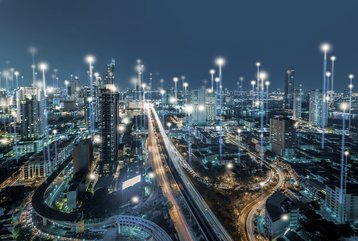When we look into the future, we have a terrible habit of underestimating it. We look at the last 10 years, how far technology has come in that time, and expect this development to be mirrored in the decade coming.
This couldn’t be further from the truth. In reality, progress follows the law of accelerating returns and the last 10 years saw significantly more growth than the decade before.
Explained as simply as possible, the ‘law of accelerating returns’ is based on the principle that as we develop more technology, further growth becomes easier to conceive. We learn from experience, and faster due to the resources available to us.
When we think about this velocity, smart cities seem just around the corner, and as a concept are heavily reliant upon data centers for their success.
“The world population presently stands at approximately 7.7 billion people, with nearly four billion or 54 percent living in cities today. By 2050, it's projected that more than two-thirds of the world population will live in urban areas, with seven billion of the expected 9.7 billion people occupying cities globally.”
Marc Cram, the director of new market development for Server Technology, a brand from Legrand, sees these population densities as directly related to the development of smart cities. This is, in part, due to necessity. As the population expands, we need to find a way to manage it effectively in the highly dense areas. Resources will be stretched and become reliant on efficiency.
“A successful smart city will depend on solutions across six major domains. Economy, environment and energy, government and education, living and health, safety and security, and lastly, mobility. The common understanding for a smart city in 2021 is one that provides for the real-time monitoring and control of the infrastructure and services that are operated by the city, thereby reducing energy use and pollution, while improving health, public safety, and the quality of life of the citizens and visitors.”
It should not go unacknowledged that this could trigger some anxiety. The concept of real-time monitoring can feel a little too Orwellian for many people’s comfort but, frankly, is already a part of our daily lives.
We are already monitored by GPS on our mobile phones - our preferences are tracked on the Internet, and microphones listen to our every conversation. The question that Smart Cities answer is how can this integration of technology help our daily lives.
This process is already beginning in New York.
“Smart, in this case, means being efficient in the use of both human and financial capital to minimize energy usage while ensuring the quality of service for public utilities such as water, electricity, and transportation, and to provide for the day-to-day safety of people and resilience of infrastructure.
“Smart means taking advantage of automation and remote management capabilities for lighting, power, transportation, and other mission-critical applications to keep the city running. With thousands of cameras and millions of sensors already in use around New York City, they are already well on their way to being a smart city that processes over 900 terabytes of video information every single day.
“Recently, the city of New York committed grant monies for the development of a couple of new IoT-based applications that will likely require the use of smart street lighting that is available through the New York Power Authority.
“First, is a real-time flood monitoring pilot project led by the City University of New York and New York University to help understand flood events, protect local communities, and improve resiliency. Two testbed sensor sites - one in Brooklyn and the other in Hamilton, which is a power beach in the Queen's area which has a history of nuisance flooding. The software solution that is being tested must act as an online data dashboard for residents and researchers to access the collected flood data
"Secondly, the city is testing computer vision technologies that automatically collect, and process, transportation mobility data through either a live video feed, recorded video, or through some sort of site-mounted sensors. Currently, street activity data is collected through time and person-intensive methods that limit the location, duration, accuracy, and number of metrics available for analysis. By incorporating computer vision-based automated counting technology, the city hopes to overcome many of these limitations with flexible solutions that can be deployed as permanent count stations, or short duration counters with minimal setup costs and calibration requirements.”
At some point, this technology could develop even further, interacting with citizens on a personal level by utilizing Edge computing. As Cram pointed out, “for example, the light fixture can be a WiFi device. A desk itself could be outfitted with sensors to detect how warm or cool you are, and measure movement to suggest getting up and walking around for a period of time.”


